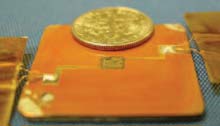Page 1 of 1
Intel Cooling Chips with Thermoelectrics
Posted: Tue Jan 27, 2009 9:32 am
by Apoptosis

- The thermoelectric cooler shown above (center gold square) is attached to a copper plate that is used to spread heat away from hot spots on chips.
- 2e_x220.jpg (4.18 KiB) Viewed 3903 times
Now researchers at Intel, RTI International of North Carolina, and Arizona State University have shown that it's possible to build an efficient microrefrigerator that can target hot spots on chips, saving power and space, and more effectively cooling the entire system. Their work also demonstrates, for the first time, that it is possible to integrate thermoelectric material into chip packaging, making the technology more practical than ever before. A paper detailing the research was just published in Nature Nanotechnology.
"People have been talking about using high-efficiency thermoelectric materials for cooling hot spots on chips for years," says Intel manager Ravi Prasher. He says that part of the reason he and his colleagues were able to succeed is because they used a material that has shown exceptional thermal properties, and they relied on Intel's knowledge of chip packaging to build an integrated thermoelectric system that was engineered to fit within the confines of a chip's housing.
Source
Re: Intel Cooling Chips with Thermoelectrics
Posted: Tue Jan 27, 2009 12:39 pm
by DMB2000uk
Is intel starting to be thermal limited for clock speeds again or something?
Dan
Re: Intel Cooling Chips with Thermoelectrics
Posted: Tue Jan 27, 2009 2:07 pm
by GI-JOE
Dunno, I wonder if this will up the costs of their cpus?

Re: Intel Cooling Chips with Thermoelectrics
Posted: Tue Jan 27, 2009 6:49 pm
by vicaphit
I wonder where they got the gold-plated dime!
Re: Intel Cooling Chips with Thermoelectrics
Posted: Wed Jan 28, 2009 9:25 pm
by Kougar
DMB2000uk wrote:Is intel starting to be thermal limited for clock speeds again or something?
Dan
It is more efficient to cool a 25mm^2 area than to cool the entire inside of a computer... something like this makes far more sense than IBM's approach of designing water channels through the die itself and pumping water through it.
Link
It might even be cheaper to built a few of those into a CPU in order to cut down the size of the accompanying cooler, something Intel has long since done already with their cooler sizes. From what I've read heat has a much higher impact on memory controller frequency than on the core circuitry as well.
Re: Intel Cooling Chips with Thermoelectrics
Posted: Thu Jan 29, 2009 3:44 am
by DMB2000uk
TEC's still output just as much heat as they take away on the cold side. So it's not like you are magically getting rid of all the CPU heat in the rest of the case.
Dan
Re: Intel Cooling Chips with Thermoelectrics
Posted: Thu Jan 29, 2009 6:58 pm
by martini161
exactly. a watt is a watt no matter what you do to it
Re: Intel Cooling Chips with Thermoelectrics
Posted: Fri Jan 30, 2009 12:04 am
by Kougar
DMB2000uk wrote:TEC's still output just as much heat as they take away on the cold side. So it's not like you are magically getting rid of all the CPU heat in the rest of the case.
Dan
Doh.

Okay, just ignore me. I know how a TEC works so I don't know what I was thinking there...
](./images/smilies/eusa_wall.gif)
Still, chilling parts of a core such as the IMCs (or uncore for i7) would allow better IMC clockrates from what I've read before. I've seen some uncore performance scaling tests on an original Phenom (at Madshrimps) and between raising the memory speeds, HT Link speed, NB speed, and Core frequency, the NB frequency had the second largest impact on performance only to the core frequency. As both Core i7 and Phenom 2 run the NB / uncore at reduced frequencies, there is plenty of "room" left to go before they reach frequency parity with the cores. Due to heat and/or other reasons the uncore / NB frequency still doesn't overclock nearly as far as the CPU itself.